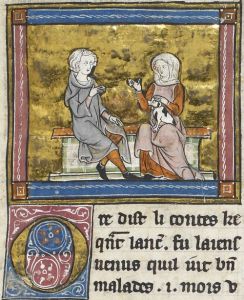I am reliably informed that it was National Pet Day the other day.
This made me think about writing a piece about Mediaeval pets. What did people keep and how did they view them?
Naturally there wasn’t the great variety of pets people keep now. No exotics for examples, lizards, spiders and snakes. Many people kept dogs and you might be surprised to learn that fewer people kept cats than they do today.

Cat with a rat. Imgur.com
Cats were more or less considered feral and the property of the whole village. The whole village would feed the animals if they were unable to feed themselves. Of course, they were kept in the hope they would feed themselves; on the vermin in the barns and grain stores; the mice and voles nibbling away at the crops of the field and gorging themselves on the stores of the home.
There’s a lot of folklore about cats. According to one old legend, cats were the only creatures on earth who were not made by God at the time of Creation. They sprang, it’s said, from the mouths of a lion and lioness in Noah’s ark in order to kill all but the original two rats which had multiplied and were eating the ark’s stores. He reason why cats are haughty to this day! Such a good deed!

The ark cat. Pinterest
In the 1st century BC, the Greek historian Diodorus reported the fate of a hapless Roman in Egypt who’d caused the death of a cat: “The populace crowded to the house of the Roman who had committed the ‘murder’; and neither the efforts of the magistrates sent by the King to protect him nor the universal fear inspired by the might of Rome could avail to save the man’s life, though what he had done was admitted to be accidental.” One wonders if this veneration has come down to us today?
They were considered rather special there and then but gradually their place at the head of the pet animal kingdom was usurped by that ever faithful and useful creature, the dog. Dogs were often associated with the world of faery and possessed the power to see the long dead, recognise witches and other supernatural creatures. Indeed they became supernatural themselves. Think about all the black dogs you’ve heard of roaming, amongst other places, Dartmoor.

Themoorlander.com Black Shuck.
In addition to possessing the ability to see spirits or to grant wishes, dogs were also venerated for their healing abilities. Ha! Are we only now beginning to see the benefits of dog owning? Men have been understanding it for centuries.
Dogs often find themselves at the centre of magic. Remember the three witches in Macbeth? ‘Wool of bat and tongue of dog.’ What other parts of the dog ended up in a brew, we ask?
The faithfulness and selflessness of the dog is and never has been in dispute. In Welsh folklore, the story of Gelert serves to illustrate how dog is man’s best friend.
In the legend, Llywelyn the Great returns from hunting to find his baby missing, the cradle overturned, and Gelert with a blood-smeared mouth. Believing the dog had savaged the child, Llywelyn draws his sword and kills Gelert. After the dog’s dying yelp Llywelyn hears the cries of the baby, unharmed under the cradle, along with a dead wolf which had attacked the child and been killed by Gelert. Aw, that brings a tear to the eye

The legend of Gelert – Wikipedia.
People obviously often felt the same about their pets as we do today with bones of animals being found in graves and the ubiquitous monuments with a warrior’s feet resting on his trusty canine companion. Never parted, not even in death. Though we must add that this is a convention with somewhat hidden meanings too.
In my first novel, we meet my main man, Aumary Belvoir with the dog of his youth and early manhood, Samson a sort of hunting dog related to our greyhound or whippet. How sad he is when this dog is fatally poisoned. Yes, there is evidence that people loved their dogs as much as we do, in the Middle Ages.

Types of hunting dogs. Pinterest.
Of course dogs had to earn their keep; hunting dogs must bring down prey, small dogs rather like terriers must go to ground to flush out rabbits and foxes. Even tinier dogs were employed to catch rats. Some lucky dogs were mere lap dogs for wealthy ladies – even in nunneries – their function being to take the love and devotion which was denied to the celibate inmates!

The lap dog blogs.bl.uk
People also kept birds, of course, in cages or attached to little chains by their foot. Well, we’d better gloss over that one. I can’t bear caged birds.

The bird catcher Pinterest

The ferret. Pinterest
And another animal kept as a pet but which had a use, was the ferret, very good for catching rabbits. We sometimes see illustrations of them in manuscripts sitting on the mistress’ knee or being used in the hunt.

Pet Squirrel. Larsdatter.com
Would you believe it but the squirrel too was kept as a pet? Aristocratic ladies loved those. To illustrate how much they loved them, there is a fifteenth-century love ring, French or English, whose inside engraving features a woman with a leashed squirrel, at the British Museum.

British Museum ring c. 1400
I have a friend who is a re-enactor who has a pet squirrel in her 14th century persona. Don’t worry. It’s not a real one, it’s a repurposed stuffed one!

Rosalie Gilbert with Scarlet her squirrel. Rosalie’s Medieval Woman.
Animals were not generally thought to possess souls at the time about which I write, (even if it’s thought today, one has to subscribe to the belief that everything does), and so they were here mainly for man’s use. God had put them on earth for man to command. One could do as one wished with an animal (some horrible people still do,) and not face censure. They perhaps weren’t as (depending on your view), mawkish or overly sentimental about them, as we might be today.
This is why I find it odd when people who read my books then complain how I treat animals in them. One lady went as far as to say that she’d never read another of my books because I allowed 2 dogs to die in the first one. <LAUGH> If she’d read to the end perhaps she would have been happy to learn that 2 different dogs get their revenge on the perpetrator of the horrors! Should she be reading Mediaeval novels at all? If she is so terribly affected by what happened in those days, shouldn’t she stick to nice twee little potboilers instead? I reflect what happened to real people and animals in my books. Sorry if you don’t like the nasty truths of history. I can’t change the past (though I know some people are trying to do just that!)
The book coming out next in the Savernake series is called Though I Live Not Where I Love, another one based on a folk song.
In this you’ll find a dedication at the beginning. As I was writing this book, in 2017, my canine companion Samos (Samsy) who was not quite four, was killed. To this day I mourn him. He was my heart dog, as they say, one which captured my heart – well they all do – but this one was special as he had survived the most awful treatment in Spain as a street dog. A beautiful fully pedigree wire fox terrier, he’d been kicked out of a Spanish home at the tender age of 6 months or so and left to fend for himself. You can imagine how he was when I adopted him. He survived so many horrors, to be hit by a car in a freak accident. This book is dedicated to him.
As a character says of his dog, in this book, out soon:
‘A possession more valuable than gold. More desirable and loyal than the love of a woman. More worthy than the worthiest king.’

My angel Samsy.
Content retrieved from: https://susannamnewstead.co.uk/2021/04/16/1171/.

